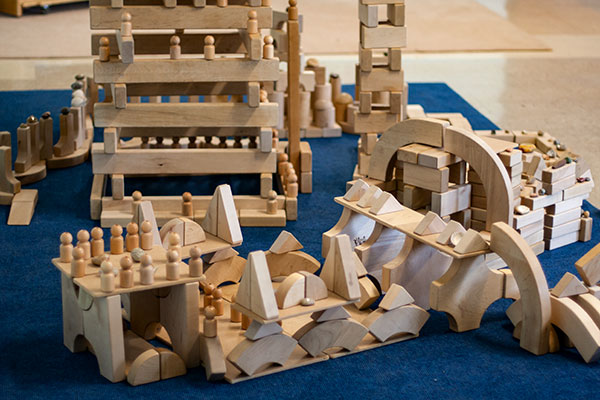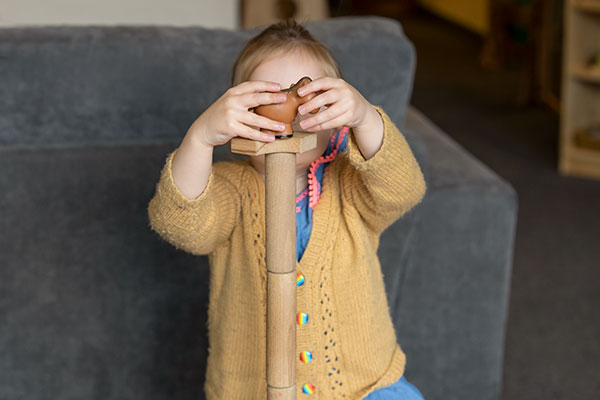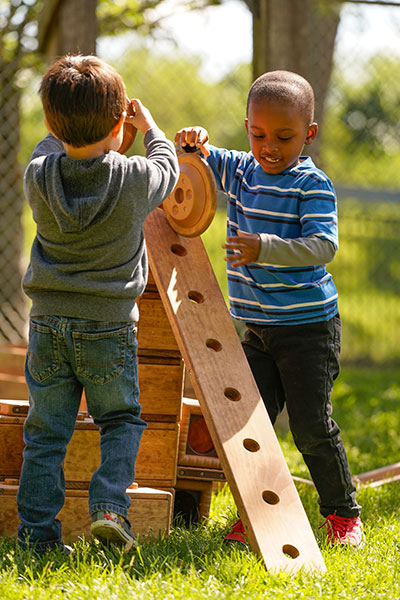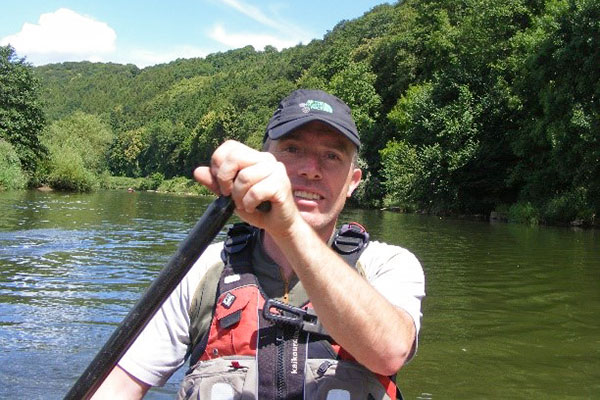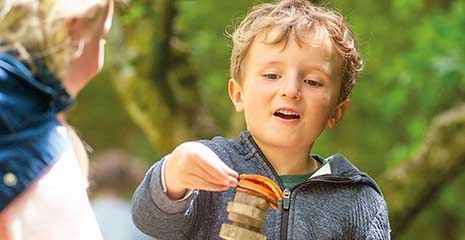Block play and child development
An interview with Daniel Spry
| May 2020Daniel Spry is a passionate advocate of block play and delivers block play training to educational settings across the UK. In this interview, he discusses the many benefits of quality block play for children’s development and how the role of the adult is so important.
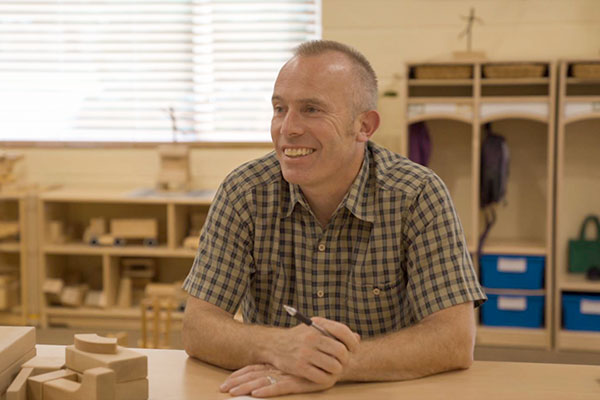
Community Playthings: Can you tell us a little about yourself and your work?
Daniel: Hi – my name is Daniel Spry, and I currently work four days a week for Cheshire West and Cheshire Local Authority as an Early Years Consultant. On the fifth, I specialise as an independent consultant delivering block play training nationally.
After finishing school, I was an outdoor pursuits instructor for six years, working both abroad and subsequently in East London. Eventually I retrained to become a teacher. During my training I had the choice to specialise in early years, and something about it just really hit home with me. I became a reception teacher, and it’s the best thing I ever did: working with young children.
I have always been committed to blocks because I have seen the benefits in terms of outcomes for children. Blocks are not just another fad that comes along and goes, like you see with some of the writing and phonics initiatives. Block play is an underpinning staple of education. Anyone who wants the best for children should factor block play into the equation, in my opinion.
The role of block play in children's learning and development
Community Playthings: How does block play support the various areas of learning and development?
Daniel: There are not that many other resources that allow children to be working in all areas of learning at once. There’s a lot of negotiation, there’s communication and language, and maths is often implicit. Children will be building towers and then they’ll be comparing and counting the blocks without realising it. They will be measuring distance when they are looking at bridging. They will be using symmetry, again, maybe without realising it or giving it that name.
When I was a reception teacher, I had blocks in my classroom, some plastic ones, some little wooden ones, but I didn’t actually have the unit blocks. Those were something I had to learn about. The first thing I did was read Exploring Learning: Young Children and Blockplay by Pat Gura and Tina Bruce, and that was a really good foundation. On the back of that, I contacted Community Playthings, knowing that you were the people that manufactured the unit blocks. The person I talked to invited me and a few of my colleagues down to visit, and we got to see the blocks being made in the factory. This trip, during which we also had the chance to observe incredible block play at a local nursery, combined with the information from Tina and Pat, really set us on our way.
I then researched Friedrich Froebel. He developed his own educational philosophy over a period of years, which he then documented in his book The Education of Man written in 1826. I was able to visit Keilhau in Germany in 2016, which is where Froebel started the first kindergarten. This visit was very inspiring – I was even able to flip through the pages of Froebel’s personal copy of The Education of Man in the museum there. Froebel inspired Caroline Pratt, who developed the unit block in 1913 in America. She wanted larger blocks than Froebel’s, but she based her design on his original block dimensions. Caroline Pratt’s unit blocks were produced accurately to ensure stability during building. Every block within the set is a mathematical unit of the other blocks, so children are implicitly developing their maths skills without realising it.
A lot of emphasis is put on reading, writing, storytelling and maths, but actually if you can’t be creative, how can you solve problems? That’s what the blocks help you to do – you turn a problem over, not only in your mind, but also in your hands. You’re solving problems while playing with blocks, and you are thinking creatively to do that. We talk about literacy skills: how can children be expected to sit down later on and write a story if they don’t understand the process of telling a story? If children are telling stories to themselves through their play, and as practitioners we understand and we can capture that, then we can use that to support them.
One of the things that I find fascinating is how blocks support children with low language skills. Somebody once said to me: “it’s because the blocks don’t need a language, they have their own language.” That’s so true. A child can understand that if I’m stacking, I’m building a tower. If I’m putting the blocks on the floor, then I’m creating a road, and so they don’t necessarily need the language to be able to play together and to understand what’s being built. Then, because they are able to work together as they play, it opens up an opportunity for them to start communicating verbally. That’s a really powerful thing.
I really do believe that building play is, next to fighting, probably one of the oldest forms of play in the world because it has a real purpose. When you were play fighting with your friends, you were learning to be a hunter, you were learning to protect yourself and your family and gather food. Actually, when you are playing building, you are meeting the other need – you are meeting Maslow’s hierarchy of needs: shelter, and safety. To think about it in those terms is amazing. I grew up in quite a rural area, and that was one of the things me, my brothers and cousins were always doing – we were always out building dens and enjoying that type of play.
Block play offers a form of unity within the construction material. In nature, there are so many materials that we can construct with: stones, branches, and logs, and we can build to a point, but actually when we come into the classroom the unit blocks are a resource that can standardise and bring order to those things that we create. When a child builds with unit blocks, they know that each block is the same, or that they are mathematically a unit of each other. So they can build uniform walls of the same length, and they can place blocks on top, and they know that they’re not going to topple over and fall. This gives children confidence in their building.
There are actually three main concepts that a child develops when they are building. The first one is stacking: we can stack horizontally and vertically. Once we’ve got the stacking nailed, then we’ve got bridging. And that bridging comes because we think: “I’ve stacked a pile, oh look I can get a car through there.” Finally, we begin to create enclosures. When we enclose something, it’s generally for a purpose. It might be that we’ve got an animal or car, so we’re creating a barn or garage. Once a child understands those three main concepts, there’s nothing that they can’t build or get their head around. And you think about the room that we’re in now – you can see the breeze blocks – there’s the stacking in the wall. And then we’ve got these lovely black girders – that’s the bridging. And of course the room is an enclosure. After grasping these basic techniques through building with the blocks, children can understand how this room is put together, and there’s no reason why, as they grow up, they can’t go on to build this room.
There’s been quite a bit of research around the stages of block play, and there have also been some people that think they’re slightly different. And I would say they are a nice guide to have – they get you as a practitioner thinking about what you’re seeing, and that’s the important thing. The seven stages of block play are:
Stage 1: Carrying – This is an introductory stage, where the child may handle and carry the blocks around without necessarily building anything at all. They’re getting to know the feel and weight, the smoothness and the smell, and the sounds they can make by tapping them together, so it’s a sensory welcome to the world of blocks.
Stage 2: Stacking – Building begins as children learn to stack the blocks both vertically and horizontally. And, not to forget, it’s fun bashing these structures over!
Stage 3: Bridging – Children start to create simple bridges, which expands the building possibilities greatly.
Stage 4: Enclosures – Now children line up blocks to enclose an area. At this stage it’s great to add small world animals and people, or natural loose parts to extend children’s play.
Stage 5: Patterns and symmetry – Building becomes steadily more imaginative. There are an endless variety of patterns to create with different sizes and shapes of blocks.
Stage 6: Early representational – Structures are built and then used by children to enhance their role play.
Stage 7: Later representational – Children use the blocks to create representations of places or buildings they know, and begin to plan their build before starting construction.
The role of the adult is crucial – as a practitioner, you need to be able to understand what you’re seeing. The stages of block play give you a framework to interpret what you’re seeing in terms of understanding in children’s block play. Understanding the stages helps adults support children, because then the adult will maybe provide some additional resources in the environment to extend the learning. You are also less likely to be pushing them to do something that’s ahead of their stage. If you’re recognising where they are you’ll be supporting them around that, rather than trying to build a structure with them that maybe is too complex and too far removed from where they are developmentally. So the seven stages help a practitioner gauge their approach and their practice, I think, more than giving them the idea: “that child is definitely at stage 2 or 3”, for instance.
The role of the teacher in block play
Community Playthings: You mentioned the role of the adult in block play. Could you say a bit more about that?
Daniel: It’s crucial that the adults understand their role within block play, because, without that understanding adult, high-quality block play is less likely to happen. They set the environment up initially. If the environment isn’t set up correctly, then children won’t access the blocks in the appropriate way and they won’t get the best from them. The adults also set the daily routine. In some daily routines that I’ve observed there are just too many transitions, or the children have so many things to get done throughout the day that actually there just isn’t the time for them to really get into building, and developing their ideas, before having to move on to something else.
Practitioners are setting that routine and allocating the time for block play. They have the responsibility to ensure that the blocks and block area are fully accessible to the children. Sometimes I’ve seen areas where you’ve got the unit block storage shelf on one side and the same on the other side, leaving only a narrow corridor between them, and that’s the block area. But actually, it’s not big enough for anything. First of all, the children can’t access the shelves to get the blocks off without standing on the thing they are building. This may be developing a conflict because you’ll have children knocking structures over inadvertently whilst other children are trying to build. One way to solve this problem is to create a no-go zone just in front of the shelves to allow children to step into that space, get the resources and the blocks they need, and step out without building right in front of the shelves, but you need space to do that.
Sometimes you’ll see that a block area might double up as the carpet area, or it will be in the corridor area on the way out of the classroom to the outdoor space. Again, that’s not ideal because you’ve got children transitioning from indoors to outdoors whilst children are building. It’s potentially causing a source of conflict because structures could get knocked over by children passing through. Children also can’t come back and revisit their building after snack or lunch if the construction area doubles as the carpet area, because they’ve had to tidy the blocks away.
A lot of practitioners don’t understand how valuable it is for them to build and use the blocks. On my training courses I often hear: “Oh, I’m not really creative, I don’t really know what I’m doing.” But I’ve found that, when they start building (I build a lot of practical building time into the session so that adults can get past that apprehension) they create simple structures and then just see where it takes them. Then they are more likely to be able to sit alongside children and build. This adds value, because if a child sees a practitioner building a structure, they’ll think: “that’s really interesting, aww, I might copy that” or “that’s great, I want to do that.” If the practitioner can build and use the blocks they can also understand what they are seeing from the children. If they understand how to build a tower, and they understand the complexity of enclosures and things like that, it helps them to gauge where children are at.
Another big thing that the practitioners really need to be doing is observing the children in their play – observing so they really, really understand what they are seeing. When children are building and constructing, no matter what they are doing, there is some sort of narrative playing out, whether it’s in their head or they are in a collaborative story with other people. They’ll be building a castle, or a carport, or a bridge over a river, and there will be some sort of narrative we can observe. I really think this helps us understand the creativity of children, and it underpins so much else within the foundation stage.
Block play training
Community Playthings: How did the block trainings begin and develop?
Daniel: Between 2006 and 2008, the government released a transformation fund to local authorities to support settings in making improvements to the environment and quality of the resources for children. This came at a time when the statutory requirements were changing. After teaching for some time, an opportunity came up to join the early years team in our local authority and I’ve now been there for about 15 years. In our authority, my line manager wanted to provide a top quality training package alongside resources, so we weren’t just giving away the money and letting people get on with it. What we would do is provide settings with an excellent resource, and then give them training that would help them to use it.
As we created the block training, we realised that there is an incredible amount to think about surrounding block play. We considered the place of the blocks within the learning environment, the role of the adult, child development, and the recent changes to the EYFS. We discussed the seven stages of block play, and came up with an outline for the training.
I have now been working with block play since 2008, and see the value of block play trainings for practitioners and the children in their care. Knowing their immense value to children’s education I purchased a full school set of unit and full school set of hollow blocks, enough to allow me to train between 25 and 30 practitioners. I now travel with them in my trailer all over the UK delivering block training. It sounds like a bit of a cliché maybe, but it has been an honour to work with all these people and to help them understand the potential they can unlock by providing block play to children.
Love for the great outdoors
Community Playthings: What do you enjoy doing when you’re not working?
Daniel: Before I became a teacher, I was an outdoor pursuits instructor. My dad, before he passed away, was a farmer and I’ve always loved being outside. I grew up playing in the woods and building dens, so being outside has always been a big part of who I am. Once I went into teaching, I took every opportunity to bring my outdoor experience into the classroom and to the children I worked with. I soon realised there was a lot of crossover with my teaching in the outdoor services. Children learn through play, and when you are teaching someone to canoe or sail, you can show them the technique but then they can only learn it by going and doing it.
Open canoeing is a big passion of mine. I was really fortunate in 2011 when I went to Canada on a month long trip down the South Nahanni, a Northern Canadian wilderness river. There were six of us and we were airdropped by float plane into a lake in the mountains, and then 380 miles later we came to the confluence of the river – where the Nahanni (which we were paddling) merged with the Laird River. We were self-sufficient on that trip – it was brilliant.
In the UK, I love going to Scotland and doing extended trips in my canoe. My wife is a canoeist as well and we’ve always taken our children with us and done things as a family, and that’s been brilliant. Now they are in their mid to late teens they’re becoming really independent, confident paddlers. Last summer, I helped a friend of mine run a family canoe week in North Wales. I was so proud of my son when he taught a younger boy to canoe solo. For me that was really rewarding, knowing the journey that he’s been on and the fact that he’s now able to pass that information on to another child and get them canoeing.
I also love walking the dog and riding my motorbike, which I use for work a lot because it’s much more user-friendly than a car for me as I ride around visiting the different settings. I take the odd block with me now and again, if I’m talking at a conference, but I don’t take the big box trailer with all my resources! When you’re canoeing down a river you’ve got to be aware of the hazards, you’ve got to be aware of what the water’s doing and where you are going, so I think that’s a really good transferable skill. I see quite a few parallels between my canoeing and motorbiking.

